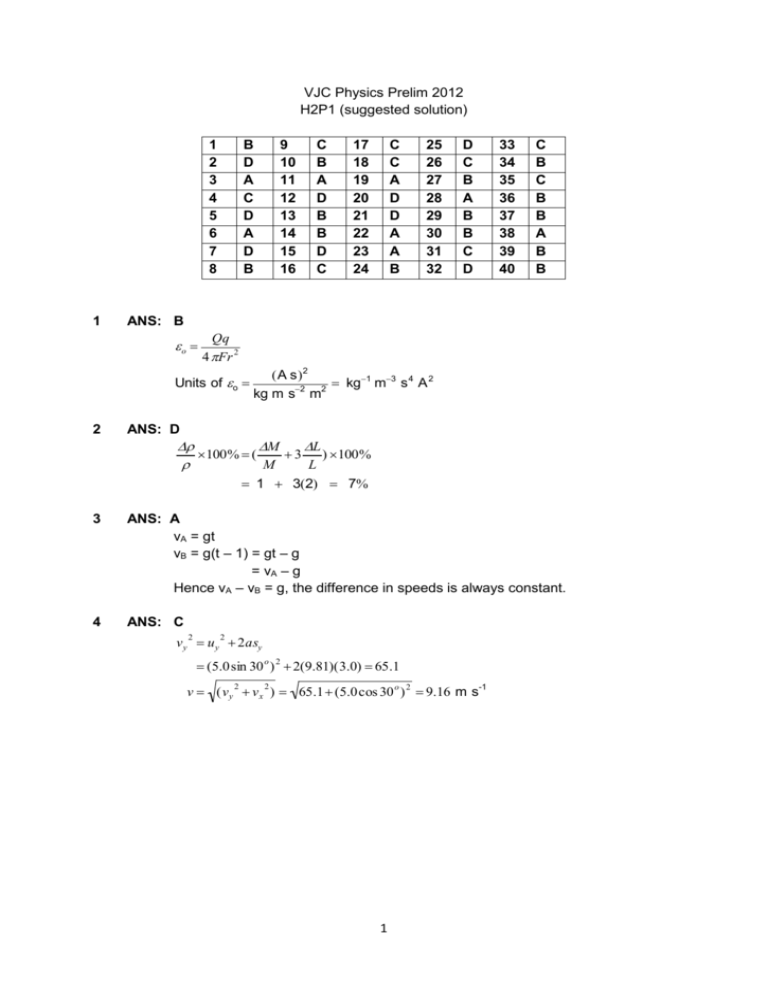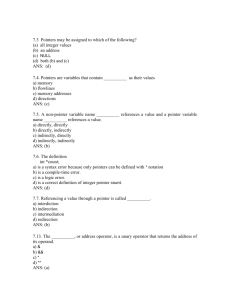2012-VJC-PH-H2-P1-Prelim-soln
advertisement

VJC Physics Prelim 2012 H2P1 (suggested solution) 1 2 3 4 5 6 7 8 1 B D A C D A D B C B A D B B D C 17 18 19 20 21 22 23 24 C C A D D A A B 25 26 27 28 29 30 31 32 D C B A B B C D 33 34 35 36 37 38 39 40 C B C B B A B B ANS: B o Qq 4 Fr 2 Units of o 2 9 10 11 12 13 14 15 16 (A s) 2 kg1 m3 s 4 A 2 2 2 kg m s m ANS: D M L 100% ( 3 ) 100% M L 1 3(2) 7% 3 4 ANS: A vA = gt vB = g(t – 1) = gt – g = vA – g Hence vA – vB = g, the difference in speeds is always constant. ANS: C 2 2 v y u y 2asy (5.0sin 30 o ) 2 2(9.81)(3.0) 65.1 2 2 v (v y v x ) 65.1 (5.0cos 30 o ) 2 9.16 m s-1 1 5 ANS : D For the system, F = (1+2+3)a a = F/6 f For the 1 kg mass, F – f = (1) a f =6a - a = 5a = 5(F/6) 6 ANS : A 10 sin 30° Loss in gravitatio nal p.e . = gained in k.e. + work done against frictional force 1 mg (10 sin 30°) = mv 2 + f (10) 2 1 m g (10 sin 30°) - v 2 2 f 10 1 2.0 9.81 (10 sin 30°) - 8.02 2 10 3.4 N 2 7 ANS : D By impulse-momentum theorem, Ft = m (v-u) F (10x10-3) =0.025(60 – 0) F =150 N 8 ANS : B For perfectly inelastic collision, the two objects moved off as one with a common v. By conservation of momentum, 5.00(15.0) + 10.0(0) = (5.00 + 10.0) v v = 5.0 m s-1 2 Initial k.e.=1/2(5.00)(15.0) = 562.5 J Finall k.e.=1/2(5.00 +10.0)(5.0)2 = 187.5 J k.e. lost in collision = 562.5 – 187.5 = 375 J ANS : C 9 Let the initial speed be v. The initial k.e., ½ m v2 = E The horizontal component of velocity, vcos45° remains constant at the top of trajectory. (though the vertical component of the velocity = 0) The k.e. at the top of the trajectory = ½ m (vcos45°)2 = ½ mv2 (0.5) =½E 10 Ans : B The power supplied, P = Fv For a constant force, So 11 v s (from v 2as ) 2 P s ANS: A 2 T 2 1.7 103 rad s -1 60 60 12 ANS: D At the top of the hill, for the ball bearing to go in circular motion, mg – N = mv2/r - - - (1) where N is the normal contact force For it to remain in contact with the floor means that N ≥ 0. Then, from (1), mg – mv2/r ≥ 0 mv2 ≤ mgr - - - (2) Also, by conservation of energy when the ball rolls down the hill and then up the loop, The loss in GPE = gain in KE mg(H – 2r) = ½ mv2 => mv2 = 2mg(H – 2r) - - - (3) Subst (3) into (2), 2mg( H – 2r) ≤ mgr H ≤ 0.5r + 2r = 2.5 r Hence maximum height H = 2.5r 3 13 ANS: B For satellite A, recall that GMm mr 2 r2 T 2 r3 GM and mv 2 GMm 2 r r v GM r So for satellite B, radius r’ = ¼ r, then v’ = And the period T’ = 1 3 1 T T 4 8 14 ANS: B Gain in KE= Loss in GPE GMm GMm 1 mv 2 2 3R R GMm 3GMm 1 mv 2 2 3R 2GMm 1 mv 2 2 3R 4GM v 3R 15 ANS: D 1 v 2v 1/ 4 O X A Time taken to travel from X to A is the same as the time taken to travel from A to X. 2 Use x = x0 cos t T 2 0.50 = cos t 3 .0 t = 0.50 s 4 16 ANS: C Answer not A: you can’t tell from the graph whether the system is under critical or heavy damping. Answer not B: there is no evidence from the graph that the system will only complete 1 oscillation. Answer not D: at resonance, the amplitude remains constant. This is supported by the fact that the graph shows a fixed value for the amplitude at resonance. In fact, since the amplitude remains constant at resonance, the energy supplied must be = energy lost. 17 ANS: C When T increases, C increases very rapidly. This means that the same amount of heat (supplied at a steady rate) will produce a smaller and smaller temperature rise over time. Hence, we can rule out “A” and “D”. Heat supplied, Q = CT “Heat is supplied at a steady rate” means that the heating power P is constant, so Q = Pt = (aT3)T T P t aT 3 T 1 3 That is, t T This means that the gradient of the curve is infinite at T = 0 K, and the gradient decreases rapidly with increasing T. So the answer is C. 18 ANS: C In both situations, p and V remain the same, so pV n1RT1 n2 RT2 That is, n2 T1 n1 T2 Since no. of moles n is proportional to the mass m of the gas, we can write: m2 T1 m1 T2 So, m2 19 T1 (273 10) m1 (15) 14 kg T2 (273 30) ANS: A When = 0o, the light will pass through A, be vertically polarised, and pass through B. But it will be blocked by C. Final intensity = 0. When = 90o , the light will pass through A, be vertically polarised, and be blocked by B. Final intensity = 0. When 0o<<90o, the vertically polarised light after passing through A will have a component parallel to B. This component will pass through B. The resultant light will then be polarised parallel to B. Then when it reaches C, the horizontal component of the light will pass through C. Final intensity is non-zero. 5 20 ANS: D It will take Ah Boy ¾ of a period to reach the lowest point. T=/v = 2.8 / 1.3 = 2.15 s. Time taken = 1.62 s 21 ANS: D 1st experiment: 2nd experiment: (2)/(1) y = D/d y’ = ’D/d’ y’ = y (1) (2) λ' d λ d' = 7.0 x 10-4 x 6 .5 1 .4 4.5 0.50 = 2.8 x 10-3 m 22 ANS: A For a stationary wave to form, a whole number of segments (=/2) must be able to fit in the space between the speaker and the wall. But 2.20 m doesn’t satisfy this condition. 23 ANS: A Electric Field Strength, E dV , where the negative sign implies that potential dr decreases in the direction of the electric field strength. Since E is positive (from the graph), the direction of E is away from point A (in the positive x direction). Therefore, potential decreases in that direction. From the equation, magnitude of the change in potential is the area under this graph, dv 24 1 (7.8 5.2)(5.0 3.0) 13 V (a decrease in the positive x direction) 2 ANS: B Q 2Q 4 ( 3 d ) 4 ( d ) o o Electric Potential Energy, U qVX 3Q 5Q 3Q 12o d 5Q 2 4o d 6 25 ANS: D RA A LA B LB / RB AA AB 2 RA A LA DB 4 2 3 6 2 B LB DA 3 1 2 2 RA 12 26 ANS: C The resistance of the bulb increases with the temperature. Also, it is never zero (that’s why D is wrong). 27 ANS: B 1 When R = 0, RPQ 1 1 4 10 10 10 1 When R = 10 , RPQ 7 28 1 1 4 104 7 10 10 10 ANS: A Power dissipated, P = V2 R Since the resistors are identical, P V2 R and Q are connected in parallel, hence VS : VR : VQ or VS 2 : VR 2 : VQ 2 2: 1 :1 or 4 : 1 : 1 (Power dissipated by R is 1 unit out of 6 units) Power dissipated across R = 1 12 = 2 W 6 7 29 ANS: B Graphical approach: Step 1: Considering just 1 “cycle”, square the function. Step 2: Find the mean-square value V2 So, V2 = 10 000 V2 Step 3: Find the root-meansquare value Finally, Vrms 8 V 2 10000 100 V 30 ANS: B Let R be the resistance of the fuse. The fuse will break when the power P dissipated in 2 2 it exceeds I rms R (13 ) R . Even when the power supply is changed to a d.c. source, the same fuse will still break when P (132 ) R . This means that the fuse will break when the d.c. current exceeds 13 A. 31 ANS: C E and B1 form a velocity selector, so the ions entering B2 have the same speed. Inside B2, the ions travel in a circular path: Centripetal force = magnetic force mv 2 B 2 qv r mv r= B2q m q rB = rA B A mA qB 1 2 = 3.7 x 1.5 1 = 4.9 cm 32 ANS: D Induced emf, E Blv (5.0 105 )(17.0)(30) 25.5 mV By Fleming’s Right Hand Rule, induced current is flowing (momentarily) from the right wing to the left wing. Positive charges are accumulating on the left wing. Therefore, the left wing is at a higher potential. 33 ANS: C 9 34 ANS: B The intensity of the beam is given by total energy of all photons hitting mirror per unit time cross - sectional area of beam n hf I , where n = no. of photons hitting mirror per unit time. A nhc I A Hence, if wavelength is halved while intensity I remains constant, the number of intensity photons hitting the mirror per unit time (n) must also be halved. Hence, (B) is the correct statement. The energy of each photon is given by E hf hc . Hence, if the wavelength is halved, the energy per photon will be doubled. Hence, (A) is wrong. The momentum of each photon is given by de Broglie’s relation p h . Hence, if the wavelength is halved, the momentum of each photon will be doubled. Hence, (C) is wrong. If p is the momentum of each photon, then the change in momentum of each photon as it rebounds from the mirror is p = pf – pi = +p (p) = 2p. Since the momentum of each photon is doubled if its wavelength is halved, this means that the force exerted by each photon on the mirror will be doubled. However, from the first paragraph above, we concluded that the number of photons hitting the mirror per unit time, n, has halved. Hence, the force on the mirror will remain constant, since p has doubled but n has halved. Hence, (D) is wrong. 35 ANS: C For each photoelectric emission, hf hf 0 eVs hf hf 0 eVs e ( f f 0 ) Vs h Hence, a straight-line graph will be obtained if (f – f0) is plotted against Vs. 36 ANS: B Statement (i) is wrong. Most of the energy goes towards heating the metal target. Statement (ii) is wrong. “hc/E” is the minimum wavelength. Only statement (iii) is correct. The wavelengths of the characteristic X-ray spectral lines depend on the material used to make the target (and not the potential difference applied to accelerate the electrons). 37 ANS: B For the ruby laser, E2 is the metastable state. 10 38 ANS: A The energy gap between the valence and conduction band does not change with temperature. 39 ANS: B As the radiation can penetrate through the 1mm thick of aluminium, it should be beta particle. Consider force acting on the radiation, mv2 r mv r Bq r v, as B, q and m are constants. After penetrating the aluminium sheet, the speed Bqv will be reduced, and so the radius will be smaller. Hence point of entry must be at Y. 40 ANS: B Fraction of sample left, e N e t N0 ln 2 ( 20) 40 = 0.71 Fraction of sample that have decayed = 1 - N N0 = 1 - 0.71 = 0.29 11








